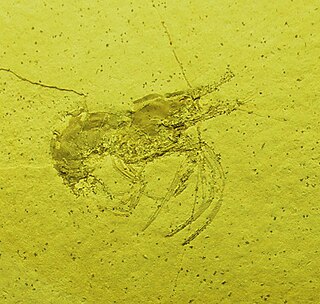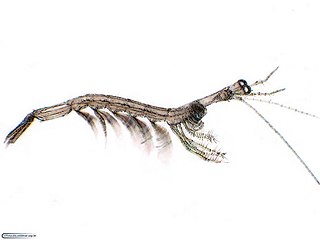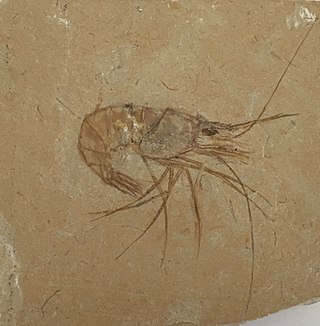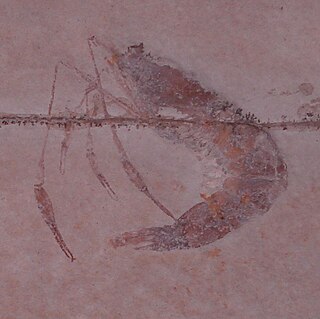
The Caridea, commonly known as caridean shrimp or true shrimp, from the Greek word καρίς, καρίδος, are an infraorder of shrimp within the order Decapoda. This infraorder contains all species of true shrimp. They are found widely around the world in both fresh and salt water. Many other animals with similar names – such as the mud shrimp of Axiidea and the boxer shrimp of Stenopodidea – are not true shrimp, but many have evolved features similar to true shrimp.

Dendrobranchiata is a suborder of decapods, commonly known as prawns. There are 540 extant species in seven families, and a fossil record extending back to the Devonian. They differ from related animals, such as Caridea and Stenopodidea, by the branching form of the gills and by the fact that they do not brood their eggs, but release them directly into the water. They may reach a length of over 330 millimetres (13 in) and a mass of 450 grams (1.0 lb), and are widely fished and farmed for human consumption.

Bylgia is an extinct genus of prawns in the family Penaeidae, containing 4 species.

The Decapoda or decapods are an order of crustaceans within the class Malacostraca, and includes crabs, lobsters, crayfish, shrimp, and prawns. Most decapods are scavengers. The order is estimated to contain nearly 15,000 extant species in around 2,700 genera, with around 3,300 fossil species. Nearly half of these species are crabs, with the shrimp and Anomura including hermit crabs, porcelain crabs, squat lobsters making up the bulk of the remainder. The earliest fossils of the group date to the Devonian.

Eucarida is a superorder of the Malacostraca, a class of the crustacean subphylum, comprising the decapods, krill, and Angustidontida. They are characterised by having the carapace fused to all thoracic segments, and by the possession of stalked eyes.

Lucifer is a little-known and degenerate genus of prawns, the type genus of the family Luciferidae. Lucifer has a long body, but many fewer appendages than other prawns, with only three pairs of pereiopods remaining, all without claws. It also bears no gills. The females, uniquely among prawns, carry the fertilised eggs on her pleopods until they are ready to hatch. This parallels the development of a similar system in pleocyemates, although the attachment is less strong in Lucifer. The length of the eye-stalks and the form of the petasma are used in distinguishing the eight species from each other.

Penaeidae is a family of marine crustaceans in the suborder Dendrobranchiata, which are often referred to as penaeid shrimp or penaeid prawns. The Penaeidae contain many species of economic importance, such as the tiger prawn, whiteleg shrimp, Atlantic white shrimp, and Indian prawn. Many prawns are the subject of commercial fishery, and farming, both in marine settings, and in freshwater farms. Lateral line–like sense organs on the antennae have been reported in some species of Penaeidae. At 210 metres per second (760 km/h), the myelinated giant interneurons of pelagic penaeid shrimp have the world record for impulse conduction speed in any animal.

Sergestoidea is a superfamily of prawns, divided into two families – the Luciferidae and the Sergestidae.

Aegeridae is a family of fossil prawns, one of the earliest Mesozoic shrimp families. It contains the genera Aeger, Acanthochirana, Anisaeger and Distaeger. The main diagnostic character of Aegeridae is the presence of numerous spines or thin setae on the third maxilliped.

Carpopenaeus is an extinct genus of prawn, which existed during the Upper Jurassic and Cretaceous periods. It contains three species.

Drobna deformis is an extinct species of prawn, the only species in the genus Drobna.

Dusa is an extinct genus of prawns, in the order Decapoda, containing five species.
Libanocaris is an extinct genus of prawn, containing two species, Libanocaris curvirostra and Libanocaris rogeri.

Longichela orobica is an extinct species of prawn which lived in the Norian, and is the only species in the genus Longichela.
Micropenaeus is an extinct genus of prawns in the order Decapoda. It was first named in 1998 by Sergio Bravi and Alessandro Garassino.

A shrimp is a crustacean with an elongated body and a primarily swimming mode of locomotion – typically belonging to the Caridea or Dendrobranchiata of the decapod order, although some crustaceans outside of this order are also referred to as "shrimp".

Prawn is a common name for small aquatic crustaceans with an exoskeleton and ten legs, some of which are edible.

Crustaceans are a group of arthropods that are a part of the subphylum Crustacea, a large, diverse group of mainly aquatic arthropods including decapods, seed shrimp, branchiopods, fish lice, krill, remipedes, isopods, barnacles, copepods, opossum shrimps, amphipods and mantis shrimp. The crustacean group can be treated as a subphylum under the clade Mandibulata. It is now well accepted that the hexapods emerged deep in the Crustacean group, with the completed group referred to as Pancrustacea. The three classes Cephalocarida, Branchiopoda and Remipedia are more closely related to the hexapods than they are to any of the other crustaceans.

Belzebub is a genus of prawns in the family Luciferidae. The species which make up the genus Belzebub were formerly placed in the genus Lucifer but were separated to form Belzebub after a cladistic analysis. They are very small planktonic and benthic prawns with an extreme lateral compression of the carapace with elongated mandibles and anteriors of the pereiopods but lacking pereiopods 4 and 5 and any gills. The pereiopods either lack chelae or they are substantially reduced. The sixth abdominal segment of males has two ventral processes and the telson has a strong ventral process.

Belzebub hanseni, the ghost shrimp or ghost prawn, is a small planktonic and benthic species of prawn from the family Luciferidae.
















